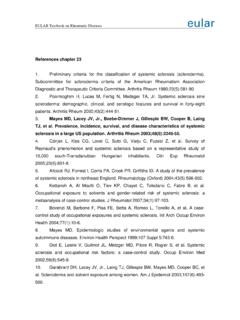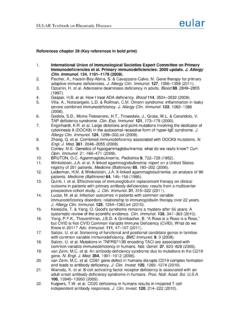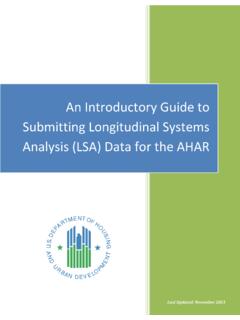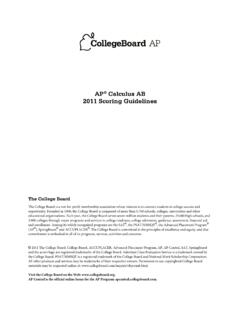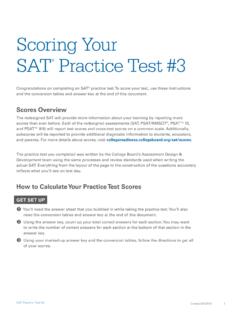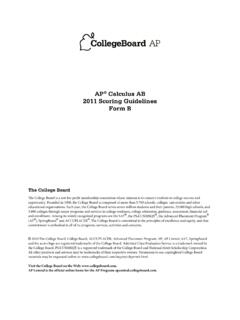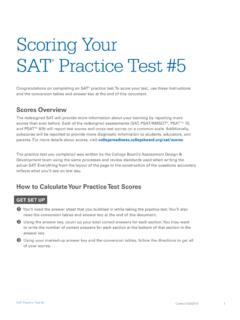Transcription of 2010 ACR/EULAR Classification Criteria for Rheumatoid ...
1 2010 ACR/EULAR Classification Criteria for Rheumatoid ArthritisPublished in the September 2010 Issues of A&Rand ARDP hases of the ProjectPhase 1 data analysisPhase 2 Consensus processPhase 3 Integration of 1 and 2 Predictors of MTX initiationFinal CriteriaDeterminants of high probability of RAIncrease feasibilityPhase 1 data Driven ApproachPhase 1: Patients and Methods Patients EARLY ARTHRITIS COHORTS 3115 patientsfrom 9 cohorts Inflammatory arthritis(no other definite diagnosis) of <3 years No previous DMARD/MTX treatment Methods PREDICTORS OF MTX TREATMENT Step 1: Univariate regression analysisof all possible variables Step 2: Principal component analysis : identify themes Step 3: Multivariate regression analysiswith all relevant themesPhase 1: Three Analytic StepsUnivariate Regression AnalysisIdentify significant variables at baselineGold standard: MTX treatment at one yearSTEP 1 Principal Component AnalysisIdentify sets of variables representing the same theme STEP 2 Multivariate regression AnalysisIdentify independent effects of variables and their relative contribution ( weight )STEP 3 STEPS 1 and 2: Predictors of MTX initiationLoadings on Factors 1%6 Factor No (Eigenvalue)1 ( )2 ( )3 ( )4 ( )5 ( )6 ( )Anit%Citrullinated peptide AB (0,1,2).
2 Factor (0,1,2). (0,1,2) (tertiles). (tertiles). (1,2%6,7%28). swelling (yes/no). swelling (yes/no). swelling (yes/no). swelling (yes/no). Joint count (1, 2%6, 7%28). tenderness (yes/no). tenderness (yes/no). tenderness (yes/no). MCP wrist :0 1 STEP 2: Relevant Themes to Predict MTX TreatmentFactorLoading variablesThemeRepresented by1 SJC, MCPSW, MCPSW-Sym MCP involvement MCP swelling2 WristSW, WristTD, WristSW-Sym Wrist involvement Wrist swelling3 TJC, MCPTD, PIPTD Hand/finger tenderness PIP or MCP or wrist tenderness4 CRP, ESR Acute phase response Abnormal CRP or abnormal ESR5 PIPSW, PIPTD PIP involvement PIP swelling6 ACPA pos., RF pos.
3 Serology Pos. ACPA or pos. RFVariableComparisonPOR (95% CI)WeightSwollen MCPPres vs. ( to ) PIPPres vs. ( to ) wristPres vs. abs < ( to ) tendernessPres vs. abs < ( to )2 Acute phaseMod. vs. normal ( to )1 High vs. normal ( to )2 SerologyMod. vs. normal < ( to )2 High vs. normal < ( to )4 Phase 1: ResultsPhase 1: Conclusion Swelling of small joint regions(PIP, MCP, wrist) has independent effect Tendernessmight be also be considered as joint involvement Symmetricalinvolvement does notseem to have a significantincremental effect over unilateral involvement Abnormal acute phase responsehas a considerable effect Serologyhas a considerable effect, and shows a dose-response relationship of titresPhases of the ProjectPhase 1 data analysisPhase 2 Consensus processPhase 3 Integration of 1 and 2 Predictors of MTX initiationFinal CriteriaDeterminants of high probability of RAIncrease feasibilityPhase 2 Consensus ApproachPhase 2.
4 Methods Ranking of patient profilesby experts for their probability to develop RA Evidence based discussion on discrepanciesin the ranking Specifyingtarget population Developing positive and negative determinantsfor risk of RA (informed by Phase 1 data ) Grouping these determinants into domains and categories Weightingof each category using decision analytic softwarePhase 2: OverviewExpert panelPhase 2: OverviewExpert panelSubmit case scenarios of early undifferentiated inflammatory arthritisRank the case scenarios on probability of developing persistent erosive RAPhase 2: OverviewExpert panelSubmit case scenarios of early undifferentiated inflammatory arthritisRank the case scenarios on probability of developing persistent erosive RASpecify target populationPositive factors+Negative factors3 Discussion on reasons for discordance among physiciansPhase 1 dataPhase 2: OverviewExpert panelSubmit case scenarios of early undifferentiated inflammatory arthritisRank the case scenarios on probability of developing persistent erosive RASpecify target populationPositive factors+Negative factors3 Discussion on reasons for discordance among physiciansPhase 1 dataIdentifying domains and categoriesPhase 2.
5 OverviewExpert panelSubmit case scenarios of early undifferentiated inflammatory arthritisRank the case scenarios on probability of developing persistent erosive RASpecify target populationPositive factors+Negative factors3 Discussion on reasons for discordance among physiciansDeriving weightsTentative CriteriaPhase 1 dataIdentifying domains and categoriesPhase 2: ResultsPhases of the ProjectPhase 1 data analysisPhase 2 Consensus processPhase 3 Integration of 1 and 2 Predictors of MTX initiationFinal CriteriaDeterminants of high probability of RAIncrease feasibilityPhase 3 Integration of Findingsfrom Phases 1 and 2 Optimizing FeasibilityExact(0%100)Rescaled(0%10)Rou nded (0%10)JOINT INVOLVEMENT1 medium%large 000>1%10 medium%large, >1%10 medium%large, >10, including at least one small (RF or ACPA)0 (<ULN)000+ (ULN to 3xULN) ++ (>3xULN) PHASE REACTANTS (ESR or CRP) DURATION<6 weeks000 6 FeasibilityExact(0%100)Rescaled(0%10)Rou nded (0%10)
6 JOINT INVOLVEMENT1 medium%large 000>1%10 medium%large, >1%10 medium%large, >10, including at least one small (RF or ACPA)0 (<ULN)000+ (ULN to 3xULN) ++ (>3xULN) PHASE REACTANTS (ESR or CRP) DURATION<6 weeks000 6 FeasibilityExact(0%100)Rescaled(0%10)Rounded (0%10)JOINT INVOLVEMENT1 medium%large 000>1%10 medium%large, >1%10 medium%large, >10, including at least one small (RF or ACPA)0 (<ULN)000+ (ULN to 3xULN) ++ (>3xULN) PHASE REACTANTS (ESR or CRP) DURATION<6 weeks000 6 CriteriaTarget Population of the CriteriaTwo requirements:(1) Patient with at least one joint with definite clinical synovitis (swelling)(2) Synovitis is not better explained by another disease Differential diagnoses differ in patients with different unclear about the relevant differentials, an expert rheumatologist should be ACR/EULARC lassification Criteria for RAJOINT DISTRIBUTION (0-5)SEROLOGY (0-3)SYMPTOM DURATION (0-1)ACUTE PHASE REACTANTS (0-1)2010 ACR/EULARC lassification Criteria for RAJOINT DISTRIBUTION (0-5)1 large joint02-10 large joints 11-3 small joints (large joints not counted)24-10 small joints (large joints not counted)3>10 joints (at least one small joint)5 SEROLOGY (0-3)SYMPTOM DURATION (0-1)
7 ACUTE PHASE REACTANTS (0-1)2010 ACR/EULARC lassification Criteria for RAJOINT DISTRIBUTION (0-5)1 large joint02-10 large joints 11-3 small joints (large joints not counted)24-10 small joints (large joints not counted)3>10 joints (at least one small joint)5 SEROLOGY (0-3)Negative RF AND negative ACPA0 Low positive RF OR low positive ACPA2 High positive RF OR high positive ACPA3 SYMPTOM DURATION (0-1)ACUTE PHASE REACTANTS (0-1)2010 ACR/EULARC lassification Criteria for RAJOINT DISTRIBUTION (0-5)1 large joint02-10 large joints 11-3 small joints (large joints not counted)24-10 small joints (large joints not counted)3>10 joints (at least one small joint)5 SEROLOGY (0-3)Negative RF AND negative ACPA0 Low positive RF OR low positive ACPA2 High positive RF OR high positive ACPA3 SYMPTOM DURATION (0-1)<6 weeks0 6 weeks1 ACUTE PHASE REACTANTS (0-1)2010 ACR/EULARC lassification Criteria for RAJOINT DISTRIBUTION (0-5)1 large joint02-10 large joints 11-3 small joints (large joints not counted)24-10 small joints (large joints not counted)3>10 joints (at least one small joint)5 SEROLOGY (0-3)Negative RF AND negative ACPA0 Low positive RF OR low positive ACPA2 High positive RF OR high positive ACPA3 SYMPTOM DURATION (0-1)<6 weeks0 6 weeks1 ACUTE PHASE REACTANTS (0-1)
8 Normal CRP AND normal ESR0 Abnormal CRP OR abnormal ESR1 6 = definite RAWhat if the score is <6?Patient might fulfill the Criteria > Prospectively over time (cumulatively) Retrospectively if data on all four domains have been adequately recorded in the pastClassification vs. Diagnosis We don t have diagnostic criteriafor RA Typically in rheumatic diseases, Criteria are labeled as Classification Criteria These are helpful in defining homogeneous treatment populationsfor study purposes A clinical diagnosis has to be established by the physician (rheumatologist) It includes many more aspects than can be included in formal Criteria Formal Classification Criteria might be a guideto establish a clinical diagnosisClassification vs.
9 DiagnosisUsually well defined, smallerClassification for studiesTarget PopulationNo diseaseDiseaseClinical DiagnosisTarget PopulationLess well defined, largerAlgorithm to Classification of RA Including RadiographsLongstanding Longstanding inactive diseasesuspected? 6/10 on the scoring system?Not RARANoRadiographsalreadyavailablePerform radiographic assessmentYesErosions typical forRA present?Yes 1 swollen joint, which is best explained by an 1 swollen joint, which is notbest explained by another disease?NoNoNoYesDocument result of the scoring systemYesYesNoSummary:Radiographic AssessmentWHEN TO PERFORMHOW TO USE The presence of typical erosions allow Classification of RA even without fulfillment of the scoring system The scoring result should nevertheless be documented in clinical studies/trials Currently, there is no exact definition of typical erosions There is work in progress to develop the respective definitionsGENERAL PRINCIPLES Radiographs are not requiredin the ACR/EULAR 2010 Classification Criteria Radiographs should not be takenfor the mere purpose of should be takenin the unclassified patient in whom longstanding inactive disease is suspected (likely failed Classification falsely)
10 Radiographs are already availablein an early arthritis patient, their information can be used for Classification purposes.( , radiographs taken by GP before referral)DefinitionsDefinitions 6 = definite RAJOINT DISTRIBUTION (0-5)1 large joint02-10 large joints 11-3 small joints (large joints not counted)24-10 small joints (large joints not counted)3>10 joints (at least one small joint)5 SEROLOGY (0-3)Negative RF AND negative ACPA0 Low positive RF OR low positive ACPA2 High positive RF OR high positive ACPA3 SYMPTOM DURATION (0-1)<6 weeks0 6 weeks1 ACUTE PH

